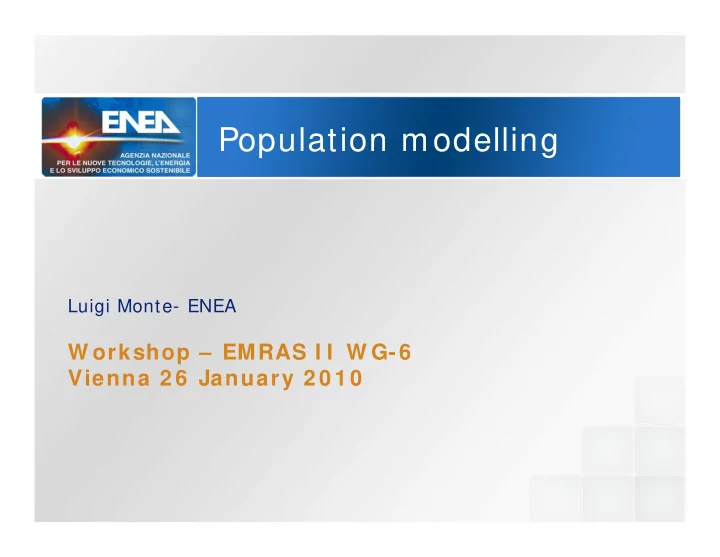

Population modelling Luigi Monte- ENEA W orkshop – EMRAS I I W G-6 Vienna 2 6 January 2 0 1 0
Principles to develop a ‘contaminant migration-population effects’ model The models should account for: (a) the dynamics and the dispersal of the biota populations; (b) the migration of the contaminants through the abiotic environmental components, the transfer from these to living organisms and, finally, the following dispersion of contaminant in the environment due to the biota movements; (c) the influence on the population dynamics of the detrimental effects caused by the environmental contamination.
Reductionistic approach The population equation: n ( x , t , a ) n ( x , t , a ) n ( x , t , a ) n ( x , t , a ) ( a ) ( x , t ) L L LNp x Mp t a The contaminant migration equation: Q ( x , t , a ) n ( x , t , a ) Q ( x , t , a ) n ( x , t , a ) n ( x , t , a ) Q ( x , t , a ) L B t a movement term mortality term natality term n ( x , t , a ) M ( x , t , a ) Equations for assessing the birth and the death rates as functions of the environmental stress (f.i., contamination and/or of the internal contamination of organisms, dose rates, etc.)
System and process aggregation The effects of ionising radiations on biological systems can occur at different levels of organisation: cells, organs, individuals, populations communities
Aggregated components The model comprises two basic groups of aggregated components: resource producers (autotrophic organisms, prevailingly green plants) consumer (heterotrophic organisms, chiefly animals, preys and predators)
Aggregated processes The complex processes of ecological nature controlling the dynamics of the species population can be summarised in three main categories: biomass development saturation effects competition among species
The biomass model equations N 1 = Producer density (kg m ‐ 2 ) N 1s = Producer density at the steady state N 2 = Consumer density (kg m ‐ 2 ) N 1s = Producer density at the steady state d N1 N2 N1 N1 N2 k1 k2 k3 1 dt d N2 * N2 N2 k4 N2 k5 N1 N2 k6 N s 2 2 dt 3 k k 5 N * 1 N 1 s
The biomass model parameters Values of the parameters and input variables used for the examples of the model applications Input variable Derived variable Variable description Value Dimension P Potential aboveground net primary production 0.9 kg m -2 year -1 minus producer biomass death rates N 1smax Producer density at steady state when 5 kg m -2 consumption by consumers is 0 N 1s Resource biomass density 3.65 kg m -2 N 2s Consumer biomass density 0.0035 kg m -2 T s Consumer decay time 0.05 year Utilisation factor of producer biomass by 0.35 dimensionless consumers L Time decay rate of consumer biomass when 0.693 year -1 competition and reproduction rate are 0 k 1 Growth rate of resource components 0.18 year -1 kg -1 m 2 year -1 k 2 Limiting coefficient of resource biomass 0.036 kg -1 m 2 year -1 k 3 Coefficient of consumption of resources by 13.9 consumers k 4 Time decay rate of consumer biomass 13.9 year -1 kg -1 m 2 year -1 k 5 Utilisation coefficient of resources by 4.86 consumers kg -1 m 2 year -1 k 6 Limiting coefficient of consumer biomass 1108 Fraction of resource consumption for consumer 0.742 dimensionless maintenance
The radiological model equations linear dose ‐ response relationship without threshold * D k k a 1 1 1 * D k k a 4 4 4
Examples of applications Scenario Zones: EZ – Exclusion Zone BRZ ‐ Biota Reservoir Zone Dose rate in the EZ 4 D ( t ) 0 . 1 * exp( 0 . 693 * t / 0 . 25 ) 1 . 25 x 10 * exp( 0 . 693 * t / 30 )
Examples of applications Combined effects of radiation dose, animal migration and human evacuation. The consumer biomass in the EZ at steady state increases in the case of enhanced animal migration stimulated by the human evacuation .
Examples of applications Time behaviour of the total biomass in the EZ due to the combined effects of radiation dose, animal migration and human evacuation. Although the biomass of predators increases due to the enhanced migration from the surrounding BR zone, the consumption of resources by consumers increases causing a decrease of the total biomass density at the steady
Examples of sensitivity analysis Time behaviour of the consumer density (normalised at Time=0) for different values of k 6 = 57, 1108, 8592 kg ‐ 1 m 2 y ‐ 1 . Simulations obtained hypothesising a dose rate constant on time (0.01 Gy day ‐ 1 ). When the competition is low (k 6 = 57 kg ‐ 1 m 2 y ‐ 1 ) the same dose rate causes a significant perturbation of the system in comparison with the effects occurring in the case of high competition (k 6 =8592 kg ‐ 1 m 2 y ‐ 1 ).
Recommend
More recommend